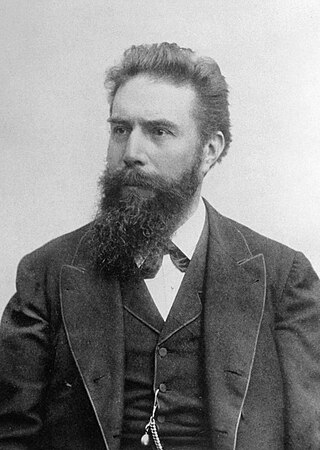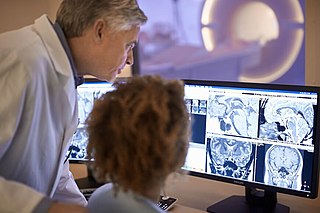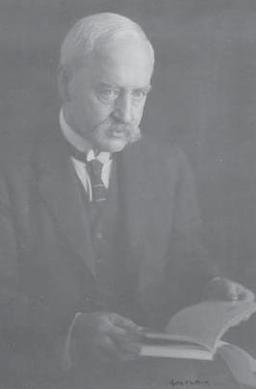
Wilhelm Conrad Röntgen was a German mechanical engineer and physicist, who, on 8 November 1895, produced and detected electromagnetic radiation in a wavelength range known as X-rays or Röntgen rays, an achievement that earned him the inaugural Nobel Prize in Physics in 1901. In honour of Röntgen's accomplishments, in 2004 the International Union of Pure and Applied Chemistry (IUPAC) named element 111, roentgenium, a radioactive element with multiple unstable isotopes, after him. The unit of measurement roentgen was also named after him.

Radiography is an imaging technique using X-rays, gamma rays, or similar ionizing radiation and non-ionizing radiation to view the internal form of an object. Applications of radiography include medical and industrial radiography. Similar techniques are used in airport security,. To create an image in conventional radiography, a beam of X-rays is produced by an X-ray generator and it is projected towards the object. A certain amount of the X-rays or other radiation are absorbed by the object, dependent on the object's density and structural composition. The X-rays that pass through the object are captured behind the object by a detector. The generation of flat two-dimensional images by this technique is called projectional radiography. In computed tomography, an X-ray source and its associated detectors rotate around the subject, which itself moves through the conical X-ray beam produced. Any given point within the subject is crossed from many directions by many different beams at different times. Information regarding the attenuation of these beams is collated and subjected to computation to generate two-dimensional images on three planes which can be further processed to produce a three-dimensional image.

Radiology is the medical specialty that uses medical imaging to diagnose diseases and guide their treatment, within the bodies of humans and other animals. It began with radiography, but today it includes all imaging modalities, including those that use no ionizing electromagnetic radiation, as well as others that do, such as computed tomography (CT), fluoroscopy, and nuclear medicine including positron emission tomography (PET). Interventional radiology is the performance of usually minimally invasive medical procedures with the guidance of imaging technologies such as those mentioned above.

Silvanus Phillips Thompson was an English professor of physics at the City and Guilds Technical College in Finsbury, England. He was elected to the Royal Society in 1891 and was known for his work as an electrical engineer and as an author. Thompson's most enduring publication is his 1910 text Calculus Made Easy, which teaches the fundamentals of infinitesimal calculus, and is still in print. Thompson also wrote a popular physics text, Elementary Lessons in Electricity and Magnetism, as well as biographies of Lord Kelvin and Michael Faraday.
Sir Peter James Kerley KCVO CBE (1900–1979) was an Irish radiologist famous for his role in the lung surgery of King George VI and the naming of the radiological sign in heart failure, Kerley lines.

Radiographers, also known as radiologic technologists, diagnostic radiographers and medical radiation technologists are healthcare professionals who specialise in the imaging of human anatomy for the diagnosis and treatment of pathology. Radiographers are infrequently, and almost always erroneously, known as x-ray technicians. In countries that use the title radiologic technologist they are often informally referred to as techs in the clinical environment; this phrase has emerged in popular culture such as television programmes. The term radiographer can also refer to a therapeutic radiographer, also known as a radiation therapist.

The Society of Radiographers (SoR) is a professional body and trade union that represents more than 90 percent of the diagnostic and therapeutic radiographers in the United Kingdom. The College of Radiographers (CoR) is a charitable subsidiary of the Society, they are collectively known as the Society and College of Radiographers (SCoR).

The Royal College of Radiologists (RCR) is the professional body responsible for the specialties of clinical oncology and clinical radiology throughout the United Kingdom. Its role is to advance the science and practice of radiology and oncology, further public education, and set appropriate professional standards of practice. The college sets and monitors the educational curriculum for those training to enter the profession, and administers the Fellowship of the Royal College of Radiologists exams. It is a registered charity in the United Kingdom (no. 211540).

The European Society of Radiology (ESR) is an international medical society based in Vienna, Austria dedicated to the promotion and coordination of scientific, philanthropic, intellectual and professional activities of radiology in Europe. In addition to various other activities, the ESR serves as an umbrella organisation for European radiologists, organises the annual European Congress of Radiology (ECR) and coordinates the publication of European Radiology, a monthly peer-reviewed medical journal. Additionally, the ESR pilots the harmonisation of teaching programmes throughout Europe with various activities and initiatives.
The Norwich Radiology Academy, opened in November 2005, is part of the Norfolk and Norwich University Hospital NHS Trust and is one of only three training centres in England specially created for training consultant radiologists. The Norwich Radiology Academy is located in the Cotman Centre on the Norwich Research Park and was formally opened in February 2006 by the President of the Royal College of Radiologists, Professor Janet Husband.
Professor Dame Janet Elizabeth Husband is Emeritus Professor of Radiology at the Institute of Cancer Research. She had a career in diagnostic radiology that spanned nearly 40 years, using scanning technology to diagnose, stage, and follow-up cancer. She continues to support medicine and research as a board member and advisor for various organisations.

Sir Thomas Ranken Lyle FRS was an Irish-Australian mathematical physicist, radiologist, educator, and rugby player.

The International Congress of Radiology (ICR) is a meeting of radiologists for the exchange of ideas and the harmonisation of international standards and practice, first held in 1925 in London and held at regular intervals since then. Since 1994 it has become a biennial event. Until 1953 each congress was organised by radiological society of the host country, but in that year, a formal organisation, the International Society for Radiology was set up to provide continuity between the congresses.
The International Day of Radiology (IDoR) is an annual event promoting the role of medical imaging in modern healthcare. It is celebrated on November 8 each year and coincides with the anniversary of the discovery of x-rays. It was first introduced in 2012, as a joint initiative of the European Society of Radiology (ESR), the Radiological Society of North America (RSNA), and the American College of Radiology (ACR). The International Day of Radiology is acknowledged and celebrated by nearly 200 national, sub-speciality, and related societies around the world. 'Radiographers Association of Madhya Pradesh(India)''' has celebrated this day since 1996 and the theme for this day was raised by '''Mr.Shivakant Vajpai''', Secretary of Madhya Pradesh Radiographers Association, also holding a designation of Radiation Safety Officer and Senior Radiographer in government of Madhya Pradesh, India.

Edith Anne Stoney was a physicist born in Dublin in an old-established Anglo-Irish scientific family. She is considered to be the first woman medical physicist.
Sudarshan Kumar Aggarwal is an Indian medical doctor and radiologist. He was honoured by the Government of India, in 2013, by bestowing on him the Padma Shri, the fourth highest civilian award, for his contributions to the field of medicine.

Charles Thurstan Holland was an English general practitioner in Liverpool who was best known by his pioneering research in the field of radiology. The Thurstan Holland sign is named after him.
Joseph Patrick Slattery, CM was an Irish-born physicist, radiologist, Catholic priest, pioneer in the field of radiography in Australia and credited with the first use of fluoroscopy in Australia.
William John Hancock D.Sc. (Hon), MIEE, MICE, LRCP was an Australian of Irish descent, an electrical engineer, telephone pioneer and pioneer in X-rays in the colony of Western Australia. He was honorary radiologist for Perth Hospital and Base Hospital in Fremantle. His list of credentials and accomplishments include M.I.E.E., Member of the Institution of Electrical Engineers, M.I.C.E., Member of the Institution of Civil Engineers, L.R.C.P., Licentiate of the Royal College of Physicians and D.Sc. (Honorary).











